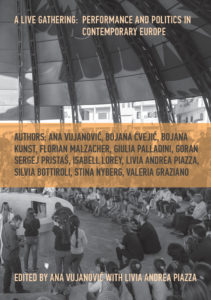A Live Gathering: Performance and politics in contemporary Europe
edited by Ana Vujanovic, with Livia Piazza,
Berlin: b_books, 2019
ABOUT THE BOOK:
The main question we raise with this book is how performance can be political in present day European representative democracy, a system which no longer draws on the live gathering of people.
Several leading European (mostly female) thinkers analyse artistic practices that have emerged alongside new social movements – such as Solidarity in Greece or Municipalism in Spain – investigating how theatre, dance and performance respond to the new political insights and experiments. It is a context wherein the previously well-known tactics and tools, such as participation, identity politics or spontaneous usage of public space don’t suffice. Thus we must build and learn a new vocabulary of politicality of performance that includes opaque words such as ‘innervation’, ‘preenactment’, ‘prefiguration’ or ‘recreation’.
ISBN 978-3-942214-29-2
For more information Look inside!
